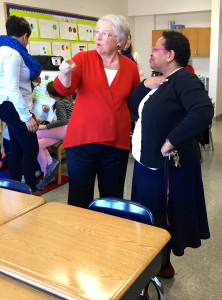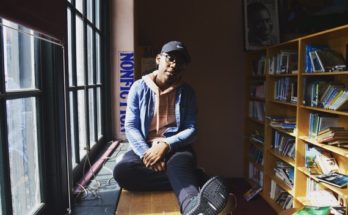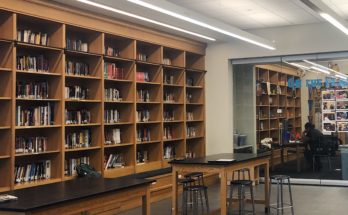A group of well-dressed public school parents gathered for a meet-and-greet last February in a Cobble Hill Brooklyn high school around platters of roast beef and turkey mini-croissant sandwiches. Students from the school’s culinary arts program ladled French onion soup into Styrofoam bowls, all in an effort to entice new parents to consider The School for International Studies, a French dual language school for sixth through twelfth graders.
Heather Herron-Lisbon, a mother of four and member of the school’s Parent Teacher Association, floated from table to table offering Kahlua and Scotch-infused brownies on white rectangular platters. “I made them this morning,” she said, urging parents to try one of each. Herron-Lisbon and her family moved last year to Brooklyn, where she set about combing the neighborhood to find a school with a good French program. Her children had been in a French immersion school previously in California and she wanted them to continue studying the language.
French dual language public schools are relatively new for New York City. Most of the existing dual language programs are Spanish, intended primarily for low-income immigrant children to become competent in English. Unlike bilingual programs that eventually aim to transition children out of all Spanish to all English classes, dual language schools involve the entire school population. Half the curriculum is taught in English, the other half in Spanish, to all children. A number of dual language schools are Chinese, and a few others include Russian, Arabic, Hebrew, and Haitian Creole. Students are meant to emerge fluent in two languages.
The new French dual language schools, as well as Japanese schools, target a different population with a different goal. Data shows that in Brooklyn’s Williamsburg and Park Slope districts, the French and Japanese dual language schools serve a much higher number of white students, and a much lower number of children in poverty than the surrounding district. They tend to be parent-initiated; middle class parents looking not for English enhancement, but for enrichment purposes.

Herron-Lisbon believes the second language will provide her children future opportunities for a career in a global economy and for travel. “The world is going to get smaller,” she said. “I’ve always felt that a second language from early on is going to give my kids a huge advantage.”
In mid-January, Schools Chancellor Carmen Fariña announced that $1 million in grant money would go towards opening 40 dual language programs in New York City. The need for good language training is paramount in the city of immigrants, said Fariña, who spoke only Spanish when she first came to the United States from Spain at the age of four. “In some ways we are all immigrant children,” she said, when she announced the initiative at the United Teachers Federation headquarters in January of this year. “And as an English language learner, I know education makes the difference and these new dual language programs will give students new pathways to college or a meaningful career.”
In 2012, nearly 15 percent of public school students in New York City were new English but only 4 percent were enrolled in a dual language program. The Department of Education aims to increase that percentage by requiring that all dual language programs serve both native English and non-English speakers.
And the numbers of both parties are growing. In her book, “True American: Language, Identity and the Education of Immigrant Children,” St. John’s University Professor Rosemary Salomone identified the new non-native English speaking students “among educated native-born Americans who enthusiastically pursue dual language immersion programs for their children.” In the 1990’s, the Department of Education used models that pulled out English learners into English-as-a-Second Language program, or separated them into bilingual programs, the trend today is integrated classrooms for two-language immersion. “These newer models are achieving positive academic results in an integrative environment,” Salomone wrote.
With the requirement to include both native and non-native speakers in dual language classrooms, the Department of Education is trying to please both immigrant parents who want their children to learn English, and middle class parents who seek the bilingual advantage.
But for the parents seeking to establish schools with languages that few in New York City speak, such as Japanese and French, this mandate to fill the classroom with half English language learners can be a roadblock.
Three years ago, Yuli Fisher, a mother of two boys both under the age of three, decided to build a dual language program in her neighborhood in Brooklyn. Fisher is originally from Taiwan and fluent in Chinese, English and French. The stay-at-home mother wanted her sons to grow up bilingual. She formed a group with other mothers: Lanny Cheuck wants her son to learn Japanese so he can communicate with his grandparents, and Yumi Miki, a native of Japan, wants her son to know the language of her home country. The women researched schools and found Public School 147 in Williamsburg to be a good fit. They applied for a planning grant and received a $25,000 start up grant from the Department of Education.
The first kindergarten class of the Japanese dual language program is expected to open at P.S. 147 this fall. When enrollment numbers came in last December, the number of English-speaking families interested was well over 150, the mothers said. But finding Japanese-speaking students who also tested as English language leaners has been the biggest challenge. The Department of Education has been supportive of the program, the mothers said, but recruiting has been up to them.
“There is sort of this tension between the Department of Education fulfilling their needs and parents of English-speakers having dual language programs,” Fisher said. This requirement of a mixed class may be the challenge that prevents other parents from organizing dual language programs all together.
Miriam Thiam, a mother in the Bronx, is having difficulty getting a program up and running. She wants to start a dual language program in French, but can’t find enough French-speaking families who are on board. Last spring and the spring before, Thiam hung fliers around her East Tremont neighborhood in the Bronx to recruit parents who may be interested in opening a program. So far, Thiam has found just three other families. She said she’ll need 20 to get a program off the ground.
Thiam is following the advice of Fabrice Jaumont, the French Embassy’s education attache who helped open the first French dual language program in Brooklyn in 2007. Jaumont is spearheading a fundraising mission to expand dual language programs in New York City. There hasn’t been a surge in French migration to New York City. The French government is interested in spreading global interest in their culture and the country. Jaumont has made it his personal mission to have 7,000 students enrolled in French programs by 2020. He hands out what he calls “the road map” for starting a dual language program to any interested parents. He guides them on how to use the Department of Education’s support of dual language to their advantage and have their voices heard.
“The DOE only listens to parents and parents who have needs and who need English as a second language,” Jaumont said. He urges parents like Thiam to gather community support, find schools they like and approach principals about opening a program. He knows pressure and demand for dual language must come from the parents themselves.
“This idea that dual language, bilingual education is only serving one target—which is making immigrants learn English—that’s changing,” Jaumont said. “It’s families and communities. It’s based on people who live here and based on people who care about keeping their heritage.”
But Thiam is up against an additional struggle compared with the mothers in Williamsburg: Thiam works a full time job, like many parents in her community do. Getting the word out, organizing parents and finding a school that would agree take on a program takes time and resources. As she tracks down families, she will also have to prove that half of the students interested are English language learners. As children in her community grow, their English will improve and the chances of testing with a low level of English on the New York State Language Assessment Test decreases as well, making these students no longer English language leaners and no longer able to take the seats in the dual language class. This burden has become another major struggle for parents looking to open a school.
Diana Limongi, a native Spanish speaker and her French husband are raising their son Enzo as a trilingual speaker. She blogs about teaching language to kids in her parenting blog. Limongi began petitioning to to open a French dual language program in Astoria three years ago. This spring she finalized a list and said she now has 40 French-speaking and 70 English-speaking families interested in a program. But because many of the children aren’t in pre-k, they are not in Department of Education’s database of English language leaners.
“If I’m a French-speaking mom who doesn’t send my kid to [universal pre-kindergarten] then my kid isn’t counted,” Limongi said. “I’ve come to peace that [the program] might not happen.” District 30 Superintendent Philip Composto told her the numbers for English language learners in Astoria aren’t there. According to data from the DOE, district 30 has 7,493 English language learners.
“He’s not on board,” Limongi said. “I don’t think it’s going to happen.” Limongi counts the number of families interested, which includes children not yet of school age. But Composto and the Office of English Language Learners and Student Support must go by the numbers of English learning in pre-k.
Jaumont believes it will take more than individual parents like Dimongi to make these kinds of schools happen. It will take different communities working together.
“When you have a population in our city to create those dual language programs it’s also good for social cohesion,” he said.



